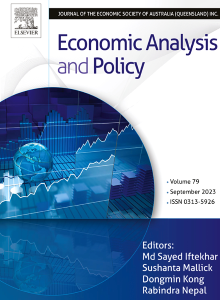The role of EU structural and investment funds in the green transition: A stochastic ray frontier analysis
IF 7.9
2区 经济学
Q1 ECONOMICS
引用次数: 0
Abstract
This study aims to provide a comprehensive picture of the effects of the European Structural Investment Funds (ESIF) employed to promote the sustainable economic growth of EU countries from 2016 to 2022. Sustainable economic growth is conceived as environmental-economic efficiency, that is the ability to decouple GDP growth from the environmental damage expressed by greenhouse gas emissions (GHGE).
The Ray Stochastic Frontier is employed to estimate the efficient frontier of the multi-output production function which incorporates GHGE as bad output. The effects of structural funds on sustainable economic growth are estimated using the efficiency effect frontier model. The study contributes to the literature by offering new empirical evidence on how cohesion policy supports the decoupling of economic growth from environmental degradation. It provides a cross-country, performance-based evaluation of ESIF’s climate relevance, offering actionable insights for optimizing fund allocation in line with the European Green Deal and Fit for 55 objectives.
The empirical analysis reveals considerable heterogeneity in green efficiency across EU countries, with some member states lagging significantly behind the efficiency frontier. ESIF investments are found to reduce environmental–economic inefficiency, demonstrating their effectiveness in promoting sustainable growth. Environmental taxation also emerges as a key institutional driver, positively influencing countries’ convergence toward green growth. Nevertheless, results indicate that progress slowed during the Covid-19 period, underscoring the need for resilient funding mechanisms.
欧盟结构性和投资基金在绿色转型中的作用:随机射线前沿分析
本研究旨在全面展示2016年至2022年欧洲结构性投资基金(ESIF)在促进欧盟国家可持续经济增长方面的作用。可持续经济增长被认为是环境经济效率,即将GDP增长与温室气体排放(GHGE)所表示的环境破坏脱钩的能力。采用射线随机边界估计以温室气体为坏输出的多输出生产函数的有效边界。利用效率效应前沿模型估计了结构性资金对经济可持续增长的影响。该研究通过提供关于凝聚力政策如何支持经济增长与环境退化脱钩的新经验证据,对文献做出了贡献。它对ESIF的气候相关性进行了基于绩效的跨国评估,为优化资金配置提供了可行的见解,符合欧洲绿色协议和55个目标。实证分析表明,欧盟各国绿色效率存在较大的异质性,一些成员国明显落后于效率边界。研究发现,esf投资减少了环境经济方面的低效率,证明了它们在促进可持续增长方面的有效性。环境税也成为一个关键的制度驱动因素,对各国向绿色增长趋同产生积极影响。然而,结果表明,在2019冠状病毒病期间,进展有所放缓,这凸显了建立有韧性的筹资机制的必要性。
本文章由计算机程序翻译,如有差异,请以英文原文为准。
求助全文
约1分钟内获得全文
求助全文
来源期刊

Economic Analysis and Policy
ECONOMICS-
CiteScore
9.80
自引率
9.20%
发文量
231
审稿时长
93 days
期刊介绍:
Economic Analysis and Policy (established 1970) publishes articles from all branches of economics with a particular focus on research, theoretical and applied, which has strong policy relevance. The journal also publishes survey articles and empirical replications on key policy issues. Authors are expected to highlight the main insights in a non-technical introduction and in the conclusion.
 求助内容:
求助内容: 应助结果提醒方式:
应助结果提醒方式:


